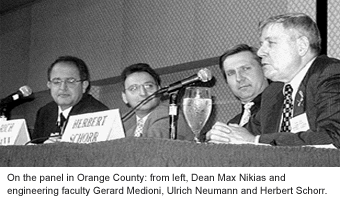USC Engineers Herald New Internet Technology by Bob Calverley
 In his first public appearance as dean of the USC School of Engineering, Max Nikias told a breakfast gathering of 250 Orange County business executives that the next fundamental Internet breakthrough will be the advent of 3-D immersive environments that encompass visual, aural and haptics (touch) technologies.
In his first public appearance as dean of the USC School of Engineering, Max Nikias told a breakfast gathering of 250 Orange County business executives that the next fundamental Internet breakthrough will be the advent of 3-D immersive environments that encompass visual, aural and haptics (touch) technologies.
“I call this vision ‘immersipresence.’ It will combine the real world with a virtual world,” said Nikias.
Describing the future of the Internet with Nikias were Herbert Schorr, associate dean and director of the Information Sciences Institute; Gerard Medioni, chair of the USC computer science department; and Ulrich Neumann, director of the Integrated Media Systems Center, all faculty in the USC School of Engineering. Their Oct. 10 presentation kicked off the 19th annual USC Orange County Executive Briefing.
With “immersipresence,” Internet users in separate locations will seem to be sitting in the same room with each other, Nikias said. Unnoticed screens and special glasses will immerse participants in a complex blend of the real and virtual worlds. They will see each other’s changing facial expressions on realistic, animated 3-D avatars, and they will be able to shake hands and eventually feel the texture of objects using haptic gloves that simulate the sensation of touch.
“In the classroom of the future, students will not only be able to see biology in 3-D, they’ll be able to navigate in it and manipulate it for their studies,” he said.
Nikias said the goal of immersipresence research at USC was “to develop technologies that allow us to interact naturally with each other.”
Scientists and engineers will have to integrate the hardware for sensory interfaces – computers, microphones, cameras, haptics and other devices – with the software to synthesize the media immersion. Nikias and the others on the panel said creating the technology to manage large amounts of data and improve security would present significant challenges.
“The IT [information technology] industry has ignored security issues,” Nikias said. The industry is adrift, he said, because of compromises made in the pursuit of profits and a lack of engineering vision.
Schorr noted that the Internet started 30 years ago as a military project. The National Science Foundation moved the technology to major universities, and then it transferred to the commercial world.
“When NSF connected major universities to the Internet, a lot of innovations, such as the World Wide Web, resulted,” he said. Schorr predicted that more innovations were on the way from the high-speed Internet2 network that universities currently use for experiments. In addition to immersive applications, he said, Internet2 would permit grid computing.
“You’ll be able to plug into a computer grid that’s like a power grid,” said Schorr.
Internet2 routinely has 50 to 100 times the data transfer capacity as a regular DSL line, which moves about one megabyte of data per second. Sometimes Internet2 has 1,000 times more speed.
Nikias noted that the government and private organizations had invested in engineering research at ISI to the tune of $55 million per year, at IMSC with $11 million annually, and in the electrical engineering and computer science departments at $20 million per year.
“You are not going to find the strengths that we have at too many other schools of engineering anywhere,” he said.
The Executive Briefing Series continues on Nov. 1 when USC President Steven B. Sample talks about his new book, “The Contrarian’s Guide to Leadership.”
Volume #21
Issue #10
USC News
3620 South Vermont Avenue
Los Angeles, CA 90089-2538
Tel: 213 740 2215 Fax: 213 740 7600
Email:USCNews@usc.edu







